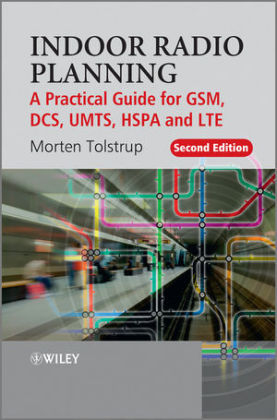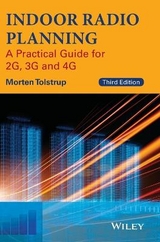
Indoor Radio Planning
Wiley-Blackwell (Verlag)
978-0-470-71070-8 (ISBN)
- Titel ist leider vergriffen;
keine Neuauflage - Artikel merken
Femtocells, outdoor DAS and tunnel radio planning are newly included in this edition. A new version of the bestseller, updated with an introduction to LTE and treatments of modulation principle, DAS systems for MIMO/LTE , designing repeater systems and elevator coverage Addresses the challenge of providing coverage inside train, and high speed rail Outlines the key parameters and metrics for designing DAS for GSM, DCS, UMTS, HSPA & LTE Essential reading for engineering and planning personnel at mobile operators, also giving a sound grounding in indoor radio planning for equipment manufacturers Written by a leading practitioner in the field with more than 20 years of practical experience
Morten Tolstrup is the Director of TE Wireless Group, International Service & Solutions. Prior to working for LGC/ADC/TE he spent 13 years in a number of different engineering positions with a mobile operator in Denmark, mainly focusing on indoor RF planning, tunnels, Airports, Pico-cells and micro cells. Over the past 15 years Morten has presented more than 50 papers and workshops at conferences around the world.
Foreword by Professor Simon Saunders xv Preface to the Second Edition xvii This is Still Not a Book for Scientists! xvii The Practical Approach xvii Keep the Originals! xviii Preface to the First Edition xix This is Not a Book for Scientists xix The Practical Approach xix Acknowledgments xxi Second Edition xxi First Edition xxii 1. Introduction 1 2. Overview of Cellular Systems 5 2.1 Mobile Telephony 5 2.2 Introduction to GSM 10 2.3 Universal Mobile Telecommunication System 28 2.4 Introduction to HSPA 58 2.5 Modulation 69 2.6 Advanced Antenna Systems for HSPA + and LTE 75 2.7 Short Introduction to LTE 81 3. Indoor Radio Planning 101 3.1 Why is In-building Coverage Important? 101 3.2 Indoor Coverage from the Macro Layer 104 3.3 The Indoor UMTS/HSPA Challenge 107 3.4 Common UMTS Rollout Mistakes 112 3.5 The Basics of Indoor RF Planning 114 4. Distributed Antenna Systems 123 4.1 What Type of Distributed Antenna System is Best? 123 4.2 Passive Components 125 4.3 The Passive DAS 133 4.4 Active DAS 136 4.5 Hybrid Active DAS Solutions 145 4.6 Other Hybrid DAS Solutions 148 4.7 Indoor DAS for MIMO Applications 153 4.8 Using Repeaters for Indoor DAS Coverage 162 4.9 Repeaters for Rail Solutions 174 4.10 Designing with Pico and Femtocells 179 4.11 Active DAS Data 188 4.12 Electromagnetic Radiation, EMR 198 4.13 Conclusion 202 5. Designing Indoor DAS Solutions 203 5.1 The Indoor Planning Procedure 203 5.2 The RF Design Process 208 5.3 Designing the Optimum Indoor Solution 217 5.4 Indoor Design Strategy 236 5.5 Handover Considerations Inside Buildings 240 5.6 Elevator Coverage 244 5.7 Multioperator Systems 258 5.8 Co-existence Issues for GSM/UMTS 265 5.9 Co-existence Issues for UMTS/UMTS 267 5.10 Multioperator Requirements 270 6. Traffic Dimensioning 275 6.1 Erlang, the Traffic Measurement 275 7. Noise 295 7.1 Noise Fundamentals 295 7.2 Cascaded Noise 302 7.3 Noise Power 310 7.4 Noise Power from Parallel Systems 314 7.5 Noise Control 316 7.6 Updating a Passive DAS from 2G to 3G 317 8. The Link Budget 329 8.1 The Components and Calculations of the RF Link 329 9. Tools for Indoor Radio Planning 345 9.1 Live and Learn 345 9.2 Diagram Tools 346 9.3 Radio Survey Tools 347 9.4 The Simple Tools and Tips 347 9.5 Tools for Link Budget Calculations 348 9.6 Tools for Indoor Predications 348 9.7 The Advanced Toolkit (RF-vu from iBwave.com) 351 10. Optimizing the Radio Resource Management Parameters on Node B When Interfacing to an Active DAS, BDA, LNA or TMA 357 10.1 Introduction 357 10.2 Impact of DL Power Offset 359 10.3 Impact of Noise Power 362 10.4 Delay of the Active DAS 362 10.5 Impact of External Noise Power 363 11. Tunnel Radio Planning 367 11.1 The Typical Tunnel Solution 368 11.2 The Tunnel HO Zone 369 11.3 Covering Tunnels with Antennas 376 11.4 Radiating Cable Solutions 378 11.5 Tunnel Solutions, Cascaded BDAs 383 11.6 Tunnel Solutions, T-Systems 385 11.7 Handover Design inside Tunnels 390 11.8 Redundancy in Tunnel Coverage Solutions 396 11.9 Sector Strategy for Larger Metro Tunnel Projects 399 11.10 RF Test Specifications of Tunnel Projects 404 11.11 Timing Issues in DAS for Tunnels 405 12. Covering Indoor Users From the Outdoor Network 413 12.1 The Challenges of Reaching Indoor Users From the Macro Network 413 12.2 Micro Cell Capacity 418 12.3 ODAS Outdoor Distributed Antenna Systems 420 12.4 Digital Distribution of DAS 423 12.5 High Speed Rail Solutions 429 References 437 Appendix 439 Reference Material 439 Index 451
| Erscheint lt. Verlag | 22.8.2011 |
|---|---|
| Zusatzinfo | Illustrations |
| Verlagsort | Hoboken |
| Sprache | englisch |
| Maße | 178 x 252 mm |
| Gewicht | 974 g |
| Einbandart | gebunden |
| Themenwelt | Technik ► Elektrotechnik / Energietechnik |
| Technik ► Nachrichtentechnik | |
| ISBN-10 | 0-470-71070-5 / 0470710705 |
| ISBN-13 | 978-0-470-71070-8 / 9780470710708 |
| Zustand | Neuware |
| Informationen gemäß Produktsicherheitsverordnung (GPSR) | |
| Haben Sie eine Frage zum Produkt? |
aus dem Bereich



